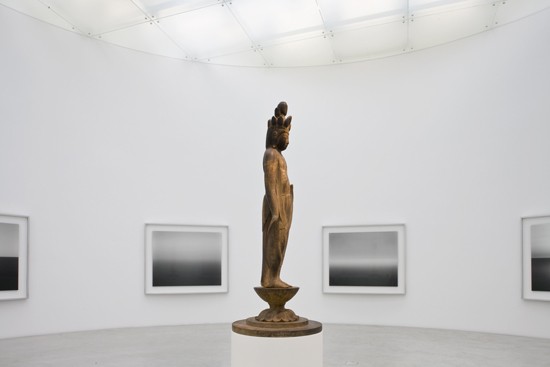 Hiroshi Sugimoto – Installation view of “Hiroshi Sugimoto: History of History” at 21st Century Museum of Contemporary Art, Kanazawa, 2008-09. Foreground: Heian period Juichimen Kannon figure (wood, c. 10-11 centuries); Background: Silver gelatin print photos from the “Seascapes” series (1980-95). Ⓒ Hiroshi Sugimoto, courtesy of Gallery Koyanagi.
Hiroshi Sugimoto – Installation view of “Hiroshi Sugimoto: History of History” at 21st Century Museum of Contemporary Art, Kanazawa, 2008-09. Foreground: Heian period Juichimen Kannon figure (wood, c. 10-11 centuries); Background: Silver gelatin print photos from the “Seascapes” series (1980-95). Ⓒ Hiroshi Sugimoto, courtesy of Gallery Koyanagi.(Tokyo) Best known for monochrome, long-exposure photographs of subjects ranging from seascapes to wax figures and turn-of-the-century machines, artist Hiroshi Sugimoto also maintains sideline careers as an antiques dealer (and collector), architect and, more recently, cultural philanthropist, having established the Odawara Art Foundation in December 2009. At a press conference in Tokyo on April 20, Sugimoto revealed that he is branching out into yet another field, that of theater direction.
The 62-year-old Sugimoto will direct a production of the Japanese bunraku puppet theater play The Love Suicides at Sonezaki (Sonezaki shinju), in consultation with leading bunraku professionals. Written in 1703 by Chikamatsu Monzaemon, the play revolves around a young clerk and his courtesan lover who commit suicide together after they realize that, due to a debt incurred following the clerk’s refusal of an arranged marriage to another woman, they will no longer be able to continue their relationship.
Based on a real event, the play in turn inspired so many copycat suicides that in 1732 the Tokugawa Shogunate banned its performance. The play was not revived until 1955, with many of the original line-reading and puppet-handling directions lost in the intervening years. That leaves plenty of room for contemporary interpretation by Sugimoto, who has titled his project Sugimoto Bunraku: Dekunobo Irinasake Sonezaki Shinju tsuketari Kannon Meguri.
Sugimoto told the assembled media that he wanted to do something that would combine elements of old and new. Notably, Sugimoto’s production will restore for the first time since Love Suicides’ original 1703 performance a prelude entitled Kannon Meguri (Kannon Pilgrimage), which anticipates the play’s first act involving the courtesan making a pilgrimage to temples dedicated to the Buddhist deity of mercy. Sugimoto said that he might even add to the set design Heian-period wooden Kannon sculptures from his own collection. While still in the early stages of planning, Sugimoto added that he is also considering integrating into the production live feeds of the on-stage action, relayed by video cameras held by “kuroko” stagehands, who in their customary black outfits are already a visible part of the performance. Other planned innovations include newly conceptualized puppet designs and stage props commissioned from diverse craftsmen.
Sugimoto cautioned, however, that there are necessary limits to how far his production can break with form. He cited in particular the movements of the puppeteers, which have been refined over centuries and are now deeply ingrained in the performers’ muscle memory, making radical changes to the choreography impractical.
Sugimoto told ART iT that he viewed the Love Suicides project as a fresh challenge compared to photography and architecture. “Working with live arts is very interesting,” he said. “As when I worked with Noh performers for my exhibition ‘End of Time’ at the Mori Art Museum [in 2006], that sense of tension and excitement they create can be as powerful as an earthquake.”
He added, “Performance is among the oldest of all art forms in Japan, with dance in particular intertwined with religion, especially when you consider the myth of Ama-no-iwato, in which dance was used to lure the sun goddess Ameterasu out from hiding.
“The roots of performance are extremely old.”
Regarding the use of video, Sugimoto told ART iT that he thought the image of kuroko stagehands holding video cameras on stage would be entertaining. “The idea came from thinking about the visual aspects of the stage,” he explained.
Sugimoto’s production will have a five-day run at Yokohama’s Kanagawa Arts Theatre from March 23-27, 2011. Currently under construction, the theater itself will open to the public in January 2011 as the latest addition to Yokohama’s port area, which has been the object of extensive cultural regeneration in recent years. The production is supported by Sugimoto’s Odawara Art Foundation, which, according to a press statement, is dedicated to the preservation, research and promotion of both traditional and contemporary Japanese art and performance.
At the same press conference, Sugimoto also introduced a major exhibition that will open on November 21 of this year at the Marugame Genichiro-Inokuma Museum of Contemporary Art (MIMOCA) in Kagawa Prefecture. Entitled “Origins of Art,” the exhibition will be divided into a four-part cycle over an almost year-long period until November 2011, with the parts addressing the themes “Science,” “Architecture,” “History” and “Religion,” respectively. “Origins of Art” will include both older works as well as those made specifically for MIMOCA.
